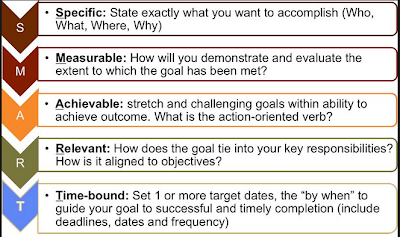This time the class started with a discussion on
S.M.A.R.T. goals. Sir asked us about the meaning of SMART Goals. We described
SMART Goals as
Specific: A specific goal has a much
greater chance of being accomplished than a general goal. To set a specific
goal you must answer the six “W” questions:
*Who: Who is involved?
*What: What do I want to
accomplish?
*Where: Identify a location.
*When: Establish a time frame.
*Which: Identify requirements and
constraints.
*Why: Specific reasons,
purpose or benefits of accomplishing the goal.
EXAMPLE: A general goal would be, “Get in shape.” But
a specific goal would say, “Join a health club and workout 3 days a week.”
Measurable - Establish concrete criteria for
measuring progress toward the attainment of each goal you set.
When you measure your progress, you stay on track, reach
your target dates, and experience the exhilaration of achievement that spurs
you on to continued effort required to reach your goal.
To determine if your goal is measurable, ask questions such
as……
How much? How many?
How will I know when it is accomplished?
Attainable – When you identify goals that are
most important to you, you begin to figure out ways you can make them come
true. You develop the attitudes, abilities, skills, and financial capacity to
reach them. You begin seeing previously overlooked opportunities to bring
yourself closer to the achievement of your goals.
You can attain most any goal you set when you plan your
steps wisely and establish a time frame that allows you to carry out those
steps. Goals that may have seemed far away and out of reach eventually move
closer and become attainable, not because your goals shrink, but because you
grow and expand to match them. When you list your goals you build your
self-image. You see yourself as worthy of these goals, and develop the traits
and personality that allow you to possess them.
Realistic- To be realistic, a goal must represent an
objective toward which you are both willing and able to
work. A goal can be both high and realistic; you are the only one who can
decide just how high your goal should be. But be sure that every goal
represents substantial progress.
A high goal is frequently easier to reach than a low one
because a low goal exerts low motivational force. Some of the hardest jobs you
ever accomplished actually seem easy simply because they were a labor of love.
Timely – A goal should be grounded within a time
frame. With no time frame tied to it there’s no sense of urgency. If you want
to lose 10 lbs, when do you want to lose it by? “Someday” won’t work. But if
you anchor it within a timeframe, “by May 1st”, then you’ve set your
unconscious mind into motion to begin working on the goal.
Your goal is probably realistic if you truly believe that it can be accomplished. Additional ways to know if your goal is realistic is to determine if you have accomplished anything similar in the past or ask yourself what conditions would have to exist to accomplish this goal.
Your goal is probably realistic if you truly believe that it can be accomplished. Additional ways to know if your goal is realistic is to determine if you have accomplished anything similar in the past or ask yourself what conditions would have to exist to accomplish this goal.
T can also stand for Tangible – A goal is
tangible when you can experience it with one of the senses, that is, taste,
touch, smell, sight or hearing.
When your goal is tangible you have a better chance of
making it specific and measurable and thus attainable.
The other possible variations of the acronym SMART are:
- S Specific | Simple | Single | Sensible | Significant
- M Measurable | Meaningful | Motivating
- A Achievable | Acceptable | Attainable | Actionable | Action-oriented | Adjustable | As-if-now | Agreed | Action plan | Achieved | Accountable | Assignable
- R Relevant | Realistic | Reachable | Rewarding | Results-oriented | Reviewable | Relative | Result-based | Reasonable
- T Time-dimensioned | Time frame | Tangible | Trackable | Time-boxed | Timely | Time-sensitive | Time-stamped | Time-bound | Time-based | Timed
Pygmalion Effect:
American psychologist R. Rosenthal observed in the 1960’s
that we tend to live up to what is expected of us and do better when treated as
if we are capable of success. This self-fulfilling prophecy is known as the
“Pygmalion effect”.
Pygmalion, a mythical Greek sculptor, created the statue of a woman so sweet, so perfect in his eyes that he fell madly in love with it, imagining it was alive. Facing such determination, the gods, led by Aphrodite, had to grant his wish and gave this “marble” woman a smile, words… breath.
So strong was his belief that it enabled Pygmalion to
transcend the constraints of a reality which seemed rigidly set in marble, and
to get what he was fervently hoping for.
Since the groundbreaking work of American psychologist R.
Rosenthal in the 1960’s, this self-fulfilling prophecy has been known as the
“Pygmalion effect”. What this social and educative sciences researcher
discovered could be either frightening or reassuring, depending on our
perspective. We tend to live up to what is expected of us and do better when
treated as if we are capable of success. So the Pygmalion effect could be
summarized as: "you get what you expect".


No comments:
Post a Comment